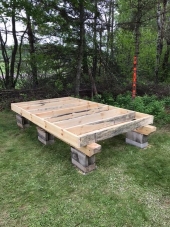




Maybe Life is always like being on a trapeze or a tightrope at the circus...
 1
1








Some people age like fine wine. I aged like milk … sour and chunky.





It is a privilege to live, work and play in the traditional territory of the Salish People.
Now drop and give me 52... ~ Come Join the permies Shoecamp! ~ All about Permies, including Tutorials ---
Twenty bucks off the homesteading bundle for the next 72 hours!









Glenn Herbert wrote:I doubt the mycelium spread all through the sapwood in one summer. I would guess it is surface mold on the pieces you show, especially as you say summers are humid there.
My father (with my help as a small child) planted maybe 10-15 acres of red pine 60ish years ago, and when it was mature, loggers had no interest in it except for pulp. It is not regarded as a good building wood around here. It might be fine as a finish material if people like the look.
Maybe Life is always like being on a trapeze or a tightrope at the circus...




John F Dean wrote:If the boards appear to be solid, I don’t think you have a problem. That said, while I have worked a great deal with oak, the only pine I have worked with has been from the lumber yard.
Maybe Life is always like being on a trapeze or a tightrope at the circus...




jordan barton wrote:Those trees appear to be mostly sapwood. They seem to have very little heart wood in them.
I kind of think this is a bust. When you pull the pieces of wood off of the mill are they covered in the black mold? Or does this happen afterwards?
Have you been drying them? Properly stacking them with stickers?
When i see them being dried here they are usually in a windy area with 1" stickers in between the boards. Mostly they are covered from the sun. In this case it might be worth it to put them in some sun to help dry them out. turn them over every few days to stop them from warping.
I am building right now and some of my floor joists have a tiny bit of the black mold on them. It is a tiny bit and they are currently in direct sunlight to help them dry out.
At my mill we have douglas fir logs which have been down for 2-3 years. Pine does not last very long stored in its log form. Balsam will become buggy, cedar can be stored for a long time. Douglas fir it is usually the sap wood to go to the bugs. Not as big a problem on large logs.
I imagine the black mold has shown up from it being stored improperly. How have you been storing the lumber after it comes off of the mill?
Maybe Life is always like being on a trapeze or a tightrope at the circus...

|
What do you have to say for yourself? Hmmm? Anything? And you call yourself a tiny ad.
Learn Permaculture through a little hard work
https://wheaton-labs.com/bootcamp
|


